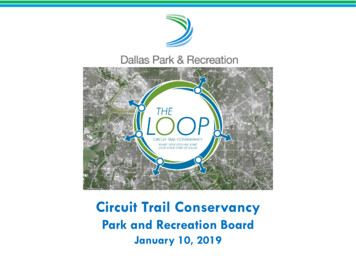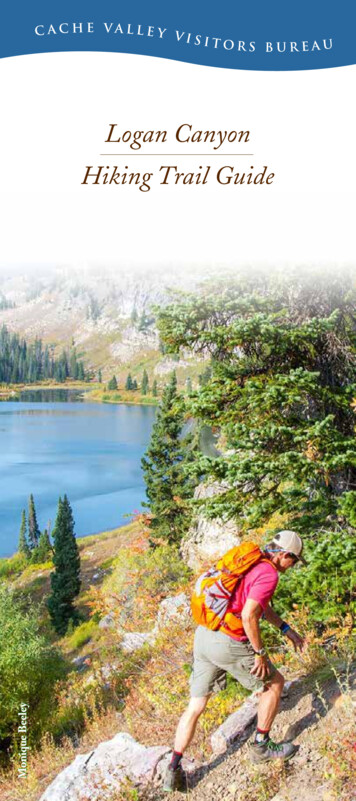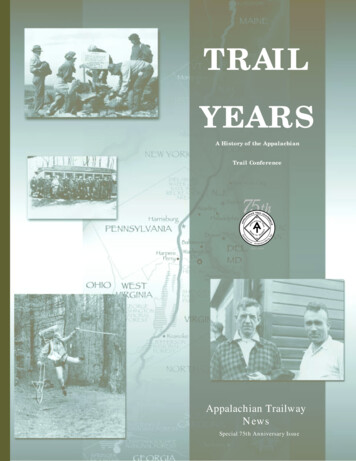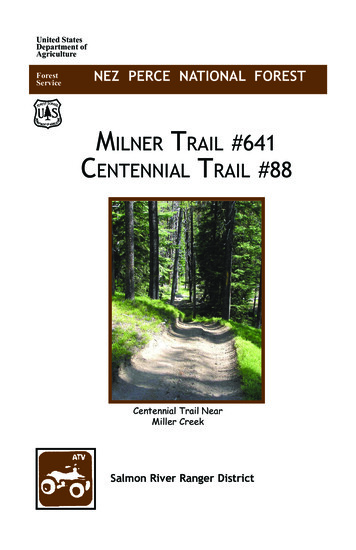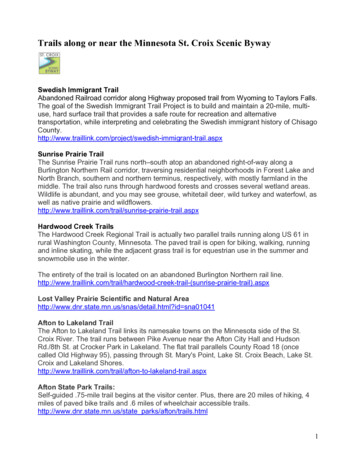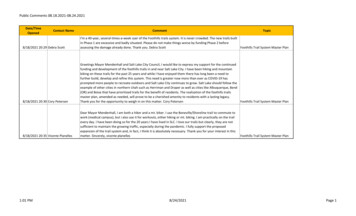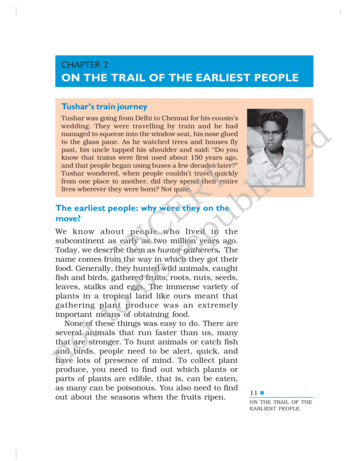
Transcription
CHAPTER 2ON THE TRAIL OF THE EARLIEST PEOPLETushar’s train journeyTushar was going from Delhi to Chennai for his cousin’swedding. They were travelling by train and he hadmanaged to squeeze into the window seat, his nose gluedto the glass pane. As he watched trees and houses flypast, his uncle tapped his shoulder and said: “Do youknow that trains were first used about 150 years ago,and that people began using buses a few decades later?”Tushar wondered, when people couldn’t travel quicklyfrom one place to another, did they spend their entirelives wherever they were born? Not quite.dehsTilRbEuCpeNr ebottThe earliest people: why were they on themove?We know about people who lived in thesubcontinent as early as two million years ago.Today, we describe them as hunter-gatherers. Thename comes from the way in which they got theirfood. Generally, they hunted wild animals, caughtfish and birds, gathered fruits, roots, nuts, seeds,leaves, stalks and eggs. The immense variety ofplants in a tropical land like ours meant thatgathering plant produce was an extremelyimportant means of obtaining food.None of these things was easy to do. There areseveral animals that run faster than us, manythat are stronger. To hunt animals or catch fishand birds, people need to be alert, quick, andhave lots of presence of mind. To collect plantproduce, you need to find out which plants orparts of plants are edible, that is, can be eaten,as many can be poisonous. You also need to findout about the seasons when the fruits ripen.on11 ON THE TRAIL OF THEEARLIEST PEOPLE
List the skills and knowledge that the childrenof these communities had.Do you have these skills and knowledge?There are at least four reasons why huntergatherers moved from place to place.First, if they had stayed at one place for a longtime, they would have eaten up all the availableplant and animal resources. Therefore, they wouldhave had to go elsewhere in search of food.Second, animals move from place to place —either in search of smaller prey, or, in the case ofdeer and wild cattle, in search of grass and leaves.That is why those who hunted them had to followtheir movements.Third, plants and trees bear fruit in differentseasons. So, people may have moved from seasonto season in search of different kinds of plants.Fourth, people, plants and animals need waterto survive. Water is found in lakes, streams andrivers. While many rivers and lakes are perennial(with water throughout the year) others areseasonal. People living on their banks would havehad to go in search of water during the dry seasons(winter and summer). Besides, people may havetravelled to meet their friends and relatives.Remember, they travelled on foot.How do you come to school?How long would it take you to walk from yourhome to school?How long would it take you if you took a bus orrode a bicycle?dehsTilRbEuCpeNr ebotton 12OUR PASTS–IHow do we know about these people?Archaeologists have found some of the thingshunter-gatherers made and used. It is likely thatpeople made and used tools of stone, wood andbone, of which stone tools have survived best.
EBdehsTilRbEuCpeNr ebottADCSome uses of stone tools are given below. Makea list of what these tools were used for and tryand decide which of these tasks could beperformed using a natural pebble. Give reasonsfor your answer.Some of these stone tools were used to cut meatand bone, scrape bark (from trees) and hides(animal skins), chop fruit and roots. Some mayhave been attached to handles of bone or wood,to make spears and arrows for hunting. Othertools were used to chop wood, which was used asfirewood. Wood was also used to make huts andtools.onStone toolsA : These are examplesof the earliest stonetools.B : These were madeseveral thousand yearslater.C : These were madelater still.D : These were madeabout 10,000 years ago.E : These are naturalpebbles.Stone tools may alsohave been used for :Left : Digging the groundto collect edible roots.Right : Stitching clothesmade out of animal skin.13 ON THE TRAIL OF THEEARLIEST PEOPLE
Choosing a place to live inLook at Map 2 below. All the places marked withred triangles are sites from which archaeologistshave found evidence of hunter-gatherers. (Huntergatherers lived in many more places. Only someare shown on the map). Many sites were locatednear sources of water, such as rivers and lakes.dehsTilRbEuCpeNr ebottMAP : 2Some Important Archaeological Siteson 14OUR PASTS–I
As stone tools were important, people tried tofind places where good quality stone was easilyavailable. Places where stone was found andwhere people made tools are known as factorysites.How do we know where these factories were?Usually, we find blocks of stone, tools that weremade and perhaps discarded because they werenot perfect, and chips of waste stone left behindat these sites. Sometimes, people lived here forlonger spells of time. These sites are calledhabitation-cum-factory sites.If you had to describe the place you live in,which of the terms would you choose?(a) habitation(b) factory(c) habitation-cum-factory(d) any otherBhimbetka (in presentday Madhya Pradesh).Some sites, known ashabitation sites, areplaces where peoplelived. These includecaves and rock shelterssuch as the one shownhere. People chose thesenatural caves becausethey provided shelterfrom the rain, heat andwind. Natural caves androck shelters are foundin the Vindhyas and theDeccan plateau. Theserock shelters are closeto the Narmada valley.Can you think of whypeople chose to live here?dehsTilRbEuCpeNr ebotton15
Sitesare places where the remains of things (tools, pots,buildings etc.) were found. These were made, usedand left behind by people. These may be found onthe surface of the earth, buried under the earth, orsometimes even under water. You will learn moreabout different sites in later chapters.dehsTilRbEuCpeNr ebottMaking stone toolsHow stone tools weremade : one of the twotechniques is shown inthe illustration.Try and identify it.Stone tools were probably made using twodifferent techniques:1. The first is called stone on stone. Here, thepebble from which the tool was to be made (alsocalled the core) was held in one hand. Anotherstone, which was used as a hammer was held inthe other hand. The second stone was used tostrike off flakes from the first, till the requiredshape was obtained.2. Pressure flaking: Here the core was placedon a firm surface. The hammer stone was usedon a piece of bone or stone that was placed onthe core, to remove flakes that could be shapedinto tools.Finding out about fireon 16OUR PASTS–IFind the Kurnool caves on Map 2 (page14). Tracesof ash have been found here. This suggests thatpeople were familiar with the use of fire. Fire couldhave been used for many things: as a source oflight, to cook meat, and to scare away animals.What do we use fire for today?A changing environmentAround 12,000 years ago, there were majorchanges in the climate of the world, with a shiftto relatively warm conditions. In many areas, thisled to the development of grasslands. This in turn
led to an increase in the number of deer, antelope,goat, sheep and cattle, i.e. animals that survivedon grass.Those who hunted these animals now followedthem, learning about their food habits and theirbreeding seasons. It is likely that this helpedpeople to start thinking about herding and rearingthese animals themselves. Fishing also becameimportant.This was also a time when several grain bearinggrasses, including wheat, barley and rice grewnaturally in different parts of the subcontinent.Men, women and children probably collectedthese grains as food, and learnt where they grew,and when they ripened. This may have led themto think about growing plants on their own.dehsTilRbEuCpeNr ebottNames and datesArchaeologists have given lengthy names for the time that we are studying.They call the earliest period the Palaeolithic. This comes from two Greekwords, ‘palaeo’, meaning old, and ‘lithos’, meaning stone. The name pointsto the importance of finds of stone tools. The Palaeolithic period extendsfrom 2 million years ago to about 12,000 years ago. This long stretch oftime is divided into the Lower, Middle and Upper Palaeolithic. This longspan of time covers 99% of human history.The period when we find environmental changes, beginning about12,000 years ago till about 10,000 years ago is called the Mesolithic (middlestone). Stone tools found during this period are generally tiny, and arecalled microliths. Microliths were probably stuck on to handles of bone orwood to make tools such as saws and sickles. At the same time, oldervarieties of tools continued to be in use.Look at the illustration on page13. Do you notice any difference in thetools belonging to these periods?The next stage, from about 10,000 years ago, is known as the Neolithic.You will be learning about the Neolithic in Chapter 3.What do you think the term Neolithic means?We have also mentioned the name of some places. You will find thenames of many more places in later chapters. Very often, we use presentday names of the places where people lived in the past, becausewe do not17 know what they called them.on
Rock paintings and what they tell usA painting from a rockshelter.Describe the painting.Many of the caves in which these early peoplelived have paintings on the walls. Some of thebest examples are from Madhya Pradesh andsouthern Uttar Pradesh. These paintingsshow wild animals, drawn with great accuracyand skill.dehsTilRbEuCpeNr ebottWho did what?We have seen that the earliest people hunted,gathered plant produce, made stone tools, andpainted on cave walls. Is there any way of finding outwhether women hunted, or men made stone tools,whether women painted or men gathered fruits andnuts? At present, we do not really know. However,there are at least two possibilities. It is likely thatboth men and women may have done many of thesethings together. It is also possible that some taskswere done only by women and others only by men.And again, there could have been different practicesin different parts of the subcontinent.Ostriches in India!on 18OUR PASTS–IOstriches were found in India during thePalaeolithic period. Large quantities of ostrich eggshells were found at Patne in Maharashtra. Designswere engraved on some pieces, while beads werealso made out of them.What do you think the beads could have beenused for?Where do we find ostriches today?A closer look – HunsgiFind Hunsgi on Map 2 (page14). A number of earlyPalaeolithic sites were found here. At some sites,a large number of tools, used for all sorts ofactivities, were found. These were probably
habitation-cum factory sites. In some of the other,smaller sites, there is evidence to suggest thattools were made. Some of the sites were close tosprings. Most tools were made from limestone,which was locally available.Can you think of a term for the second type ofsites?dehsTilRbEuCpeNr ebottElsewhereFind France in your atlas. The painting below isfrom a cave in France. This site was discovered byfour school children more than a hundred yearsago. Paintings like this were made between 20,000and 10,000 years ago. Many of these were ofanimals, such as wild horses, aurochs (an older,wild form of cattle), bison, woolly rhinoceros,reindeer and bear, painted in bright colours.These colours were made from minerals like ochreor iron ore, and charcoal. It is possible that thesepaintings were done on ceremonial occasions. Orperhaps they were made for special rituals, performedby hunters before they went in search of prey?Can you think of any other reasons?on19 ON THE TRAIL OF THEEARLIEST PEOPLE
yPalaeolithicMesolithicmicrolithsYou live in a rock shelter like the one shown on page15about 12,000 years ago. Your uncle is painting one ofthe inner walls of the cave and you want to help him.Will you mix the colours, draw the lines, fill in thecolours? What are the stories he might tell you?dehsTilRbEuCpeNr ebottLet’s recall1.Complete the sentences:(a) Hunter-gatherers chose to live in caves and rockshelters because ————————.(b) Grasslands developed around ———————— yearsago.(c) Early people painted on the ———————— of caves.(d) In Hunsgi, tools were made of ————————.2.Look at the present-day political map of thesubcontinent on page 136. Find out the states whereBhimbetka, Hunsgi and Kurnool are located. WouldTushar’s train have passed near any of these sites?Let’s discusson 20OUR PASTS–I3.Why did the hunter-gatherers travel from place toplace? In what ways are these similar to/different fromthe reasons for which we travel today?4.What tools would you use today for cutting fruit? Whatwould they be made of?5.List three ways in which hunter-gatherers used fire(see page16). Would you use fire for any of thesepurposes today?
SOME IMPORTANTLet’s do6.Make two columns in your notebook. In the left handcolumn, list the foods hunter-gatherers ate (see page11). In the right hand column, list some of the foodsyou eat. Do you notice any similarities/differences?DATESXthe Mesolithic period(12,000-10,000 yearsago)Xthe beginning of theNeolithic(10,000 years ago)dehsTilRbEuCpeNr ebott7.If you had a natural pebble like the ones shown onpage 13, what would you use it for?8.List two tasks that are performed by both men andwomen at present. List another two that are performedonly by women, and two that are performed only bymen. Compare your list with that of any two of yourclassmates. Do you notice any similarities/differencesin your lists?on21 ON THE TRAIL OF THEEARLIEST PEOPLE
Many of the caves in which these early people lived have paintings on the walls. Some of the best examples are from Madhya Pradesh and southern Uttar Pradesh. These paintings show wild animals, drawn with great accuracy and skill. Who did what? We have seen that the earliest people hunted,


